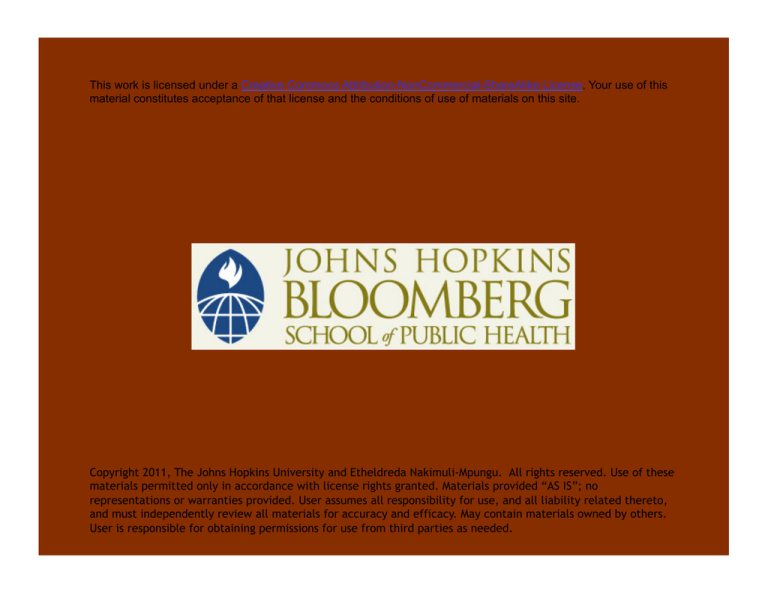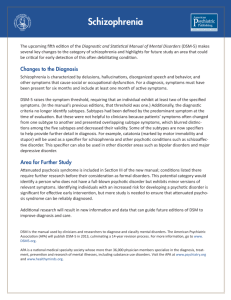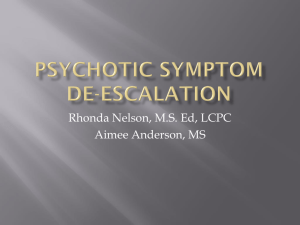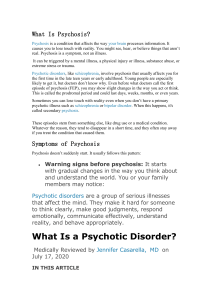
This work is licensed under a Creative Commons Attribution-NonCommercial-ShareAlike License. Your use of this
material constitutes acceptance of that license and the conditions of use of materials on this site.
Copyright 2011, The Johns Hopkins University and Etheldreda Nakimuli-Mpungu. All rights reserved. Use of these
materials permitted only in accordance with license rights granted. Materials provided “AS IS”; no
representations or warranties provided. User assumes all responsibility for use, and all liability related thereto,
and must independently review all materials for accuracy and efficacy. May contain materials owned by others.
User is responsible for obtaining permissions for use from third parties as needed.
Severe Mental Disorders
Etheldreda Nakimuli-Mpungu, MMed (Psych), MBChB
Johns Hopkins University
Dr. Etheldreda Nakimuli-Mpungu
Psychiatrist
Uganda
Mania (HIV)
3
Class Objectives
Be able to ...
- Define the primary characteristics of severe mental disorders
and how they differ from the common disorders already
discussed
- Recognize the impact of culture on various aspects of
presentation and treatment
-
Discuss the place of severe mental disorders in the realm of
global mental health issues
4
Definitions
Mental disorders: behavioral or psychological pattern that causes
significant distress and functional impairment
Severe mental disorders: chronic affective or non-affective
psychoses with extensive hospitalization
Psychosis: delusions, hallucinations, disorganized speech, grossly
disorganized or catatonic behavior
5
Section A
Psychotic Disorders
Photo by vanessa_hutd. Creative Commons BY-SA. Retrieved from
http://www.flickr.com/photos/svenjajan/3444006054/sizes/m/
Schizophrenia (SZ) DSM-IV
A. Psychotic symptoms
B. Poor functioning
C. Duration of six months
D. Not due to a mood disorder
E. Not due to substances or other disease
F. Not due to pervasive developmental disorder
7
Other Psychotic Disorders I
Schizoaffective disorder: mood episodes and psychosis occur
together
Delusional disorder: at least one month of non-bizarre delusions
without other active symptoms of SZ
Brief psychotic disorder: psychosis lasts more than one day and
remits by one month
8
Other Psychotic Disorders II
Shared psychotic disorder: delusions in an individual who is
influenced by someone else who has a longer-standing delusion with
similar content
Psychotic disorder due to a general medical condition
Substance-induced psychotic disorder
Psychotic disorder not otherwise specified
9
Schizophrenia: Clinical Presentation
Socially unacceptable behaviors
Isolation
Poor academic achievement
Neglect of body hygiene
10
Schizophrenia: Clinical Presentation
Hallucinations and delusions result in
- Unusual behaviors
-
-
-
Hyperactivity
Suspicion—refusal of food
Aggression
11
A Psychiatric Hospital in Uganda
Photo by Etheldreda Nakimuli-Mpungu
12
Mental Health Unit
Photo by Etheldreda Nakimuli-Mpungu
13
Associated Symptoms
Avolition
Anhedonia
Alogia
Blunt affect
Dysphoric mood—depression, anxiety, or anger
Disturbances in sleep pattern
Abnormalities of psychomotor activity
Difficulty in concentration, attention, and memory
Poor insight
14
Laboratory Findings
Neuro-imaging studies
Enlarged lateral ventricles in the brain
15
Prevalence and Incidence
Prevalence: 0.5% to 1.5%
Incidence: 0.5 to 5.0 per 10,000
Rates vary in different populations
16
Place Annual Incidence per 1000
Annual incidence per 1000
Aarhus, Denmark
0.18
Chandigarh, India (rural)
0.42
Chandigarh, India (urban)
0.35
Dublin, Ireland
0.22
Honolulu, Hawaii
0.16
Moscow, Russia
0.28
Nagasaki, Japan
0.21
Nottingham, England
0.22
Source: Eaton and Chen. (2008).
17
Etiology
The first-degree biological relatives of schizophrenics have a risk for
SZ that is about 10 times greater than that of the general
population
Concordance rates for schizophrenia are higher in monozygotic
twins (49%) than in dizygotic twins 25%
Adoption studies—biological relatives of schizophrenics have a
substantially increased risk for SZ, whereas adoptive relatives have
no increased risk
Stress—diathesis model
18
Course and Prognosis
Heterogeneity as to onset, course, and outcome
Considerable chronicity—long-term course is mostly stable, not
progressive
Extended prodrome and insidious onset
Outcome: 33% – 33% – 33%?
Negative—volatile positive symptoms
More benign course in non-modern settings?
Sources: Verghese et al. (1989); Srinivasan et al. (2005).
19
Acute Admission Wards for SMD
Photo by Etheldreda Nakimuli-Mpungu
20
A Convalescent Ward
Photo by Etheldreda Nakimuli-Mpungu
21








